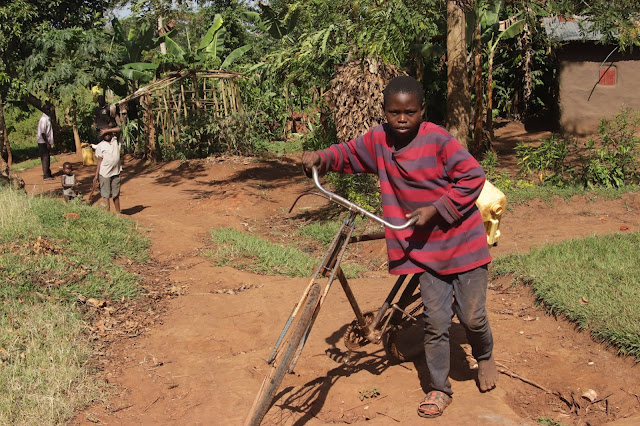Day 8 - The powerful beauty of Murchison Falls NP
The coolness of the morning is a relief from the heat of
yesterday. The sun gradually climbs higher while we see a river boat emerging
in the distance behind splashing water, at great speed. Today we continue our
descent from the Nile to the Nile Delta, the place where the Victoria Nile
flows into Lake Albert.
While the sky turns pink, the boat sails of for our
safari. In between the ‘foam’ of the Nile water (caused by a chemical reaction
of the fast-flowing waterfall with the rocks), the curious hippos emerge with
their heads alone from the water.
Curiously at who is in the boat, they look at
us with wide eyes, and then quickly lower themselves again into the protective
water. We are approved. The colorful birds of Murchison Falls NP wake up early
this morning. They color the trees on the banks with their beautiful feathering.
It is clear that the hippos are at home in the Nile. There are dozens here, say
hundreds, but there are probably thousands. As soon as the sun starts to rise, they
get in the protective water, but in a few places they are still frolicking on
the bank. Nile crocodiles lie tranquil along the waterfront with their mouths
open. Not that they're on the lookout for a snack, it's their way to cool down
a bit. On the boat, a couple of female tourists already dream aloud about
handbags and shoes ;-). The further we sail towards Lake Albert, the thinner
the vegetation on the bank becomes. The dense, impenetrable forest gives way to
the rugged plains of the savanna and swamp. And in that swamp of Uganda lives the shoebill stork that is threatened with
extinction. Only 150 of these birds
remain in Uganda. Our river boat dives
into the swamp where water lilies break through the monotony of the water. For
us, protected by the tall grass, a shoebill stork does what it does best:
standing still. This is how he spends most of his day.
The closer we get to
Lake Albert, the windier it gets. The water splashes into the boat and the
papyrus along the bank waves like a toy in the wind. Lake Albert is one of the
Great Lakes and belongs to Uganda, but also to Congo. The lake is supplied by
the Victoria Nile and flows out through
the Albert Nile through which the Nile advances towards the Mediterranean. In
the lake are some small islands, which are eagerly used by fishermen today to
find helter from the wind.
Some young fishermen are still paddling around with
their wooden boat and are happy to show their catch of today. As soon as a
hippo frolics around wildly, our young friends flee. Yes, a small wooden boat
is no match for a ferocious hippo. We enjoy the peace that Africa exudes on our
way back to the hotel. Before we go on safari tonight into the deep savanna, we
take a rest ourselves.
Elephants may not be the most ‘wild’ of the Big Five,
they remain impressive animals for their size alone. Especially when they
trumput or flutter their ears, they have my attention. It's amazing how they
collect a tasty green meal with that strong trunk, but also reap delicious
fruits.
In Murchison Falls NP there are also a large number of hartebeasts, so
called by the Boers, who thought the animal looked very much like a ‘deer’.
It
is a rather robust antelope with a strange looking literally long face. Also
walking around is the oribi, a small antelope with a distinctive black spot,
which serves as a scent gland to demarcate their territory. A Patas monkey
surveys the savannah from its imperial throne. A large group of Rotschild
giraffes treat us to a real spectacle. With their graceful grazing and elegant
movements, they seem to perform a ballet performance during the sunset.
When
night falls, a hyena almost outplays us. He sprints away just in front of our
jeep. A little further a group of hippos came ashore to fill their bellies. The
lights of the Jeep startle them and they are clearly not amused. We we don't
like to be disturbed during our meal either. However, their roar is terrifying.
The hippo belongs to the Big Five and that Big Five is not without reason the
Big Five, the animals that used to be the most difficult to hunt. For the time
being, however, we still have to make do with the Big Four.
There is always tomorrow ...









Comments
Post a Comment